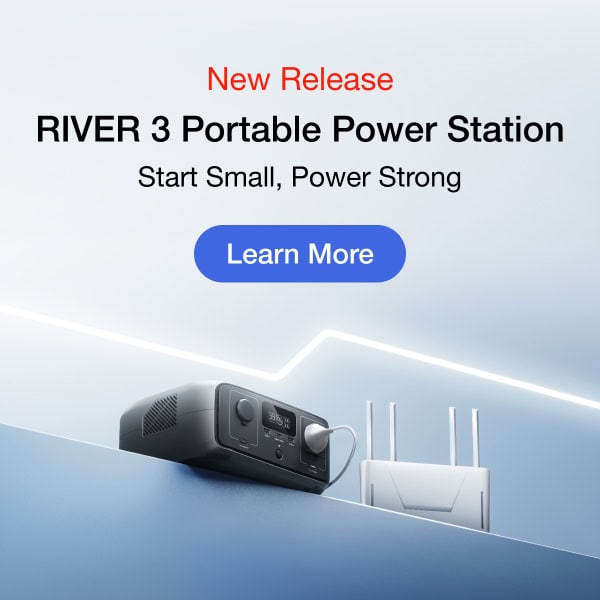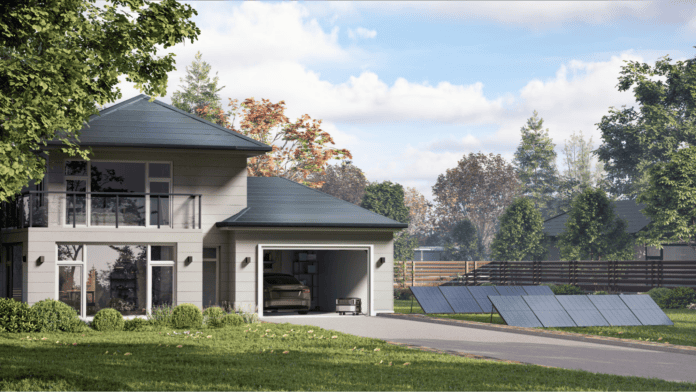Table of Contents
With the rising threat of climate change combined with advancements in solar energy, rapidly falling prices, and generous tax incentives, going solar has never been more appealing or affordable.
If you’re considering making the switch, you need to consider several things, like the size of your home and your energy needs, peak sunlight hours, your roof and local conditions, and the type and efficiency of the panels you choose.
If that sounds complicated, don’t worry. We’ll explain everything so you can determine precisely what you need for your home.
Can I Run My House on Solar Power?
You can run any home using solar panels, also called photovoltaics or PV, provided you buy the right number of modules and battery backup size to meet your needs. Understanding which photovoltaics are best for your home is essential since you must consider factors like the angle and orientation of your roof, if and when it’s shaded, and the age of your roof. Other factors can also sometimes make ground installations or portable photovoltaics more feasible.
How Many Solar Panels Are Needed to Power a House?
How many photovoltaic modules are needed to power a house varies significantly with the size of the home, the number of people living there, and your electricity usage, which depends on the appliances you use. You must examine all of those factors to size your photovoltaic system.
Let’s keep it simple by looking at the chart below, showing examples of average annual electricity use for different-sized homes, to get a general idea of your energy needs.
So, for an average small home in the UK using 1,800 kWh annually, you might need seven EcoFlow 400W Rigid Panels, while a large home using 4,100 kWh might need 15 panels. However, to get a more accurate estimate, which will help you determine the cost of your system, you will need to dive deeper into the following details.
How To Calculate the Number of Solar Panels You Need
There are a lot of factors that must be considered, including:
- Total household electricity consumption (in kWh) and the percentage you want to generate with your photovoltaics
- Average peak sun hours at your location
- Available surface area and method of installation
- On-grid, off-grid, or hybrid (PV modules + battery) balance of system
- Photovoltaic module type and efficiency
- Your budget (including any available government tax incentives)
But first, let’s give you an idea of the number you’d need. Based on average energy usage numbers, we can gain an idea of how much electricity any given photovoltaic array can generate.
Here’s how to do it.
Electricity Production Requirements in Kilowatt-Hours (kWh)
First, take the number of watt-hours (Wh) your PV array must generate to meet your energy needs. The average UK household uses about 0.3kWh per hour. Let’s take that as a starting point.
0.3kWh (hourly consumption)
Solar Irradiance and Peak Sun Hours
Next, take the number of peak sunlight hours at your location.
Irradiance varies widely by location — and even within the UK. The above map shows Global Horizontal Irradiance and projected electricity production per m2 (square meter) of photovoltaic surface.
(Source: Global Solar Atlas)
The second map shows the average daily electricity output from photovoltaic installations by region in the UK.
Solar Panel Type and Efficiency
While useful references, these maps fail to consider the type of photovoltaics installed at each location. The most common types of photovoltaic cells found in residential systems are:
- Monocrystalline
- Polycrystalline
- Thin-film
Monocrystalline silicon PV cells are significantly more efficient at producing DC electricity from available sunshine than polycrystalline or thin-film photovoltaic cells.
Aside from its meaning in common usage, solar panel efficiency is a technical specification that indicates how much electricity the cells can produce per m2 of photovoltaic surface area. The higher the percentage, the more photons will be captured and converted into DC electricity.
| Solar Panel Type | Efficiency (%) |
| Monocrystalline | 18-23% |
| Polycrystalline | 15-17% |
| Thin Film | 7-18% |
As you can see, there’s a huge variation in efficiency. Monocrystalline models with 23% efficiency will produce over 3x as much electricity per square meter as thin-film PVs that have a rating of 7%. Find out more about the different types of PV modules here.
(Source: ASES)
Number of Solar Panels: Formula and Calculator
Photovoltaic panel efficiency varies widely based on the type, quality of manufacture, and other factors like temperature.
To calculate how many PV modules you need, you must be specific about your requirements and the electricity production capabilities of the photovoltaic module you’re considering purchasing.
At best, the results of your calculations will be a working estimate. Real-world conditions are impossible to predict with absolute certainty. Therefore, it’s always wise to slightly overestimate how many PV modules you need. Or at least ensure that your solar generator or balance of system has sufficient solar charging or power input that allows you room to grow.
Peak sun hours across the UK average about 2.5 hours per day. Plymouth gets the most at 3 hours, while Aberdeen averages 2.4. Here’s the two-part formula to calculate the number of EcoFlow’s 400W rigid panels you would need to generate a daily average of 7.5kWh in Londophon (2.8 peak sun hours).
7.5kWh / 2.8 = 2.6kW
The EcoFlow 400W rigid panel generates 0.4kW per hour of peak sunlight in a lab without considering other environmental conditions. Even though these monocrystalline modules boast an industry-leading efficiency of 23%, they rarely produce that much electricity in real-world conditions.
The rated power of solar panels indicates the maximum amount of electricity a module can produce under ideal conditions.
It’s much safer to assume that the PVs will produce 75% of their rated power during peak daylight because photovoltaics rarely produce their maximum rated power in real-world conditions.
0.4kW x .75 = 0.3kW (per panel)
2.6kW / 0.3kW = 9 x EcoFlow 400W rigid PVs
You may produce MORE electricity daily, but you’re unlikely to produce less, except during extreme weather conditions or other external factors that can diminish efficiency.
If you’d like to plug in your own numbers, the two-part formula is:
Daily Electricity Consumption (kW) / Average Peak Sun Hours = Required Electricity Production (in kW)
Required Electricity Production / (Rated Power of PV Module (kW) x 0.75) = Number of Panels
Or you can use our handy solar panel calculator.
What Factors Influence How Many Solar Panels You Need?
Determine Your Energy Consumption
The first step in determining how many photovoltaic panels you need to power your house has very little to do with the panels themselves. Instead, it’s essential to determine your current household electricity consumption accurately.
Once you know how much energy your household needs, the other factors are easy to find.
Peak Sunlight Hours
PV modules produce Direct Current (DC) electricity by capturing sunlight using the photovoltaic effect. The efficiency of that process is based on peak sunlight hours when the sun is directly overhead, and the PVs produce the most energy. This varies widely depending on location; in the UK, it ranges from about 2.4 to 3 hours. The more peak sunlight you have, the fewer modules you need.
No photovoltaic (PV) module ‘works’ at night.
PVs do not produce energy at night, and overcast or cloudy days will diminish production significantly. The rated power of photovoltaics is determined in a laboratory using Standard Test Conditions.
Standard Test Conditions for Solar Panels
| Condition Type | Standard Test Condition | Real-World Conditions |
| Solar Incident Angle | Always zero, irradiation beam always normal to the PV panel* | Variable, and depends on time, date, and site latitude. In the case of rooftop systems, roof orientation, and inclination govern system capacity. |
| Solar Irradiation | Always equal to 1000 Watts/m²* | Variable and depends on the time, date, and site latitude. Limited sunshine hours bound system capacity. |
| Ambient Temperature | Always 25°C* | Variable and depends on the time, date, weather condition, and site latitude. Higher ambient temperature degrades PV panel efficiency and reduces system output. |
| Air Mass Coefficient (AM) | Always equal to 1.5* | Variable and depends on the time, date, and site latitude. Higher AM with higher latitudes. |
| System Losses | (e.g., Wiring, Inverter) Always Zero* | Variable and depends on the design and location of PV panels, inverter, and grid meter. |
*Cannot be achieved in real operation (Source: ResearchGate)
Consumers benefit from standardised testing. It helps keep manufacturers accountable for claims about product capabilities. However, real-world conditions rarely (if ever) match Standard Test Conditions.
The closest most locations get is during peak sunlight hours where solar irradiance (sunshine) may approach or exceed 1000 Watts/m².
Size of Your Home
Your home’s size impacts the number of PV modules you require in several ways.
- Electricity Consumption: As a rule of thumb, the bigger the house, the more electricity is consumed. That’s particularly true if you’ll be running heating or air-conditioning systems.
- Available Surface Area for Installation: Photovoltaic modules can be installed virtually anywhere in direct sunlight. However, most homeowners choose to install PV modules on their roofs. Ground installations are also common on properties that have sufficient space. The amount of surface area that receives direct sunlight and is suitable for mounting PV modules determines the maximum number of panels you can install to meet your renewable electricity needs.
On or Off-Grid (or Hybrid)?
Depending on your location — and your local utility provider — you may be able to opt for a grid-tied residential photovoltaic system. The difference between on-grid and off-grid is largely a question of energy independence and security.
A grid-tied system integrates with your electricity provider or utility company. When your photovoltaic array isn’t producing enough power to meet your needs, your system will automatically switch to on-grid electricity.
Depending on where you live, you may also be eligible for the Smart Export Guarantee (formerly known as the Feed-in Tariff or FiT).
(Source: Ofgem SEG Annual Report 2023)
The specifics vary by location — and your power company — but the basic principles remain the same.
The SEG scheme enables residential and commercial renewable electricity generators — like solar power — to sell electricity back to the grid by “feeding in” power produced in excess of consumption through a bidirectional (or smart) meter.
It’s rare for homeowners to actually make money through feeding in under SEG, but it can substantially reduce electricity bills.
There are advantages to on-grid systems without storage, the main one being savings on the expense of storage batteries and other balance of system components like an MPPT or PWM charge controller or storage inverter.
However, skimping on battery storage exposes an essential flaw of grid-tied systems. On-grid photovoltaic systems rely on the grid to operate. A grid-tied solar power system does NOT provide electricity during a blackout.
If you’re concerned about energy security during extreme weather events and grid failures, you’re much better off opting for a grid-tied system with battery storage.
The modular design enables you to invest as you go. You can add up to three inverters for 16kW of solar charge input — that’s 40 x EcoFlow 400W rigid photovoltaic panels.
Government Incentives, Solar Payback, and Your Budget
Last but not least, cost is an essential factor to consider when determining how many PV modules you require.
Fortunately, there’s never been a better time to switch to photovoltaics for your residential electricity needs.
If you’re a UK homeowner, taxpayer, or resident installing PV modules at your primary residence, you may be eligible for various government schemes.
UK Government Solar Incentives (Open to Eligible Applicants in 2024)
| Solar Grants | Run Dates | Eligibility | Potential Savings (If Qualified) |
| Solar Together | N/A | Homeowners and renters residing in participating council areas | 10% – 25% |
| Energy Company Obligation (EC04) | April 2022 – March 2026 | Homes in England, Scotland, or Wales. | Homeowners/residents may be eligible for free solar panels |
| Home Upgrade Scheme (HUG2) | April 2023 to March 2025 | Low-income, off-grid, and low energy efficiency-rated properties | Up to £10,000(dependent on your local council) |
| Home Energy Scotland Grant and Loan Schemes | N/A | Homes in Scotland | Up to £6,000 |
| Welsh Government Warm Homes Nest Scheme | N/A | Low-income/low-energy performance-rated Welsh homes | Homeowners/residents may be eligible for free panels |
| Solar Schemes | Run Dates | Eligibility | Potential Savings (If Qualified) |
| Smart Export Guarantee (SEG) | N/A | Households with Microgeneration Certification, export meter, and maximum capacity <5MW | 1p to +/- 25p per kWh, depending on your choice of SEG licensee and agreement terms |
| 0% VAT on Solar Panel Purchases and Installation | April 2022 – March 2027 | Purchase and installation of photovoltaic panels | 0% VAT charged on solar panel purchases. O-5% VAT on installation costs. |
By offsetting the upfront cost of switching to photovoltaics with government incentives, you can significantly shorten your solar payback period.
In addition to government incentives, there may be low or no-interest financing options to offset your initial investment when purchasing directly from a photovoltaic manufacturer.
The sooner you pay off the cost of your array, the sooner you realise a positive return on investment. Money saved on electricity bills becomes money earned.
Is My Roof Suitable for Solar Panels?
Installing PV modules on your rooftop makes sense for many reasons. Unless the surface area of your roof is heavily shaded by higher buildings, trees, or other immovable obstacles, the highest point of your home’s structure has the most access to direct sunlight.
Ground and balcony installations are viable, but if you have a roof that receives unobstructed sunlight, why wouldn’t you take advantage of the unused space to generate electricity? The good news is most rooftops have no issues supporting the weight of residential photovoltaic arrays.
Thanks to rapidly improving technology, photovoltaic modules are lighter than ever. Most weigh no more than 10-20kg per square meter, including mounting hardware. Additionally, most roofs in the UK have a pitch pitch between 30-50°, which lends well to optimal PV module orientation.
What Condition Does My Roof Need To Be In?
Unless your roof is very old or in serious disrepair, the additional weight of photovoltaics shouldn’t be an issue. Properly installed panels can offer additional protection from the elements due to their durable design and high IP ratings.
DIY installation of photovoltaics is possible but consider the pros and cons carefully. Hiring a professional installer — or at least a structural engineer to determine the integrity of your roof — ensures that you won’t damage your property and maximise electricity production from your PV array.
If you decide to go the DIY route, ensure you have the proper equipment and sufficient help to install your photovoltaic system safely and optimally.
How Much Roof Space Is Needed for Solar Panels?
The surface area required for installation depends on several factors, including:
- Electricity generation goals
- Photovoltaic module efficiency
- Rated power of photovoltaic modules
- Inverter input capacity
Depending on your needs, you can install your PV panels in series, parallel or hybrid.
Frequently Asked Questions
You must determine your household energy use and other factors to calculate how many photovoltaic panels you need. However, in general, you can use this formula:
• Daily Electricity Consumption(kW) / Peak Sun Hours = Required Electricity (kW)
• Required Electricity / (Rated Power of PV (in kW) x 0.75) = Number of Panels
It’s difficult to determine how many photovoltaic panels you need based on the number of bedrooms. It depends on the number of people in your home and their particular energy needs. However, a rough estimate is that you need between 8 and 15 400W panels.
The number of panels needed to power a full house depends on the size of the home, the number of residents, your energy usage, and the type of photovoltaics you buy. A typical estimate is that you need between 7 and 15 400W panels to power most homes.
Yes, you can produce a fully self-sufficient home using photovoltaics, where you can go off-grid and be completely energy-independent, regardless of the size of your home. It all depends on how many photovoltaic panels you buy and the size of your battery backup.
Final Thoughts
With advancements in photovoltaic technology combined with rapidly falling prices and government incentives, going solar has never been more affordable. Many factors determine the number of photovoltaic panels you need to power your home, from its size, the number of residents, and your energy usage to the number of peak sunlight hours you have and the different characteristics of your roof and garden.
Of course, the efficiency of the photovoltaic modules you purchase will also affect how many you need to buy, with highly efficient models like EcoFlow’s Photovoltaic Panels requiring fewer than less efficient models. Now, you have all the information you need to purchase a photovoltaic array and enjoy clean, green, and free energy from the sun.





